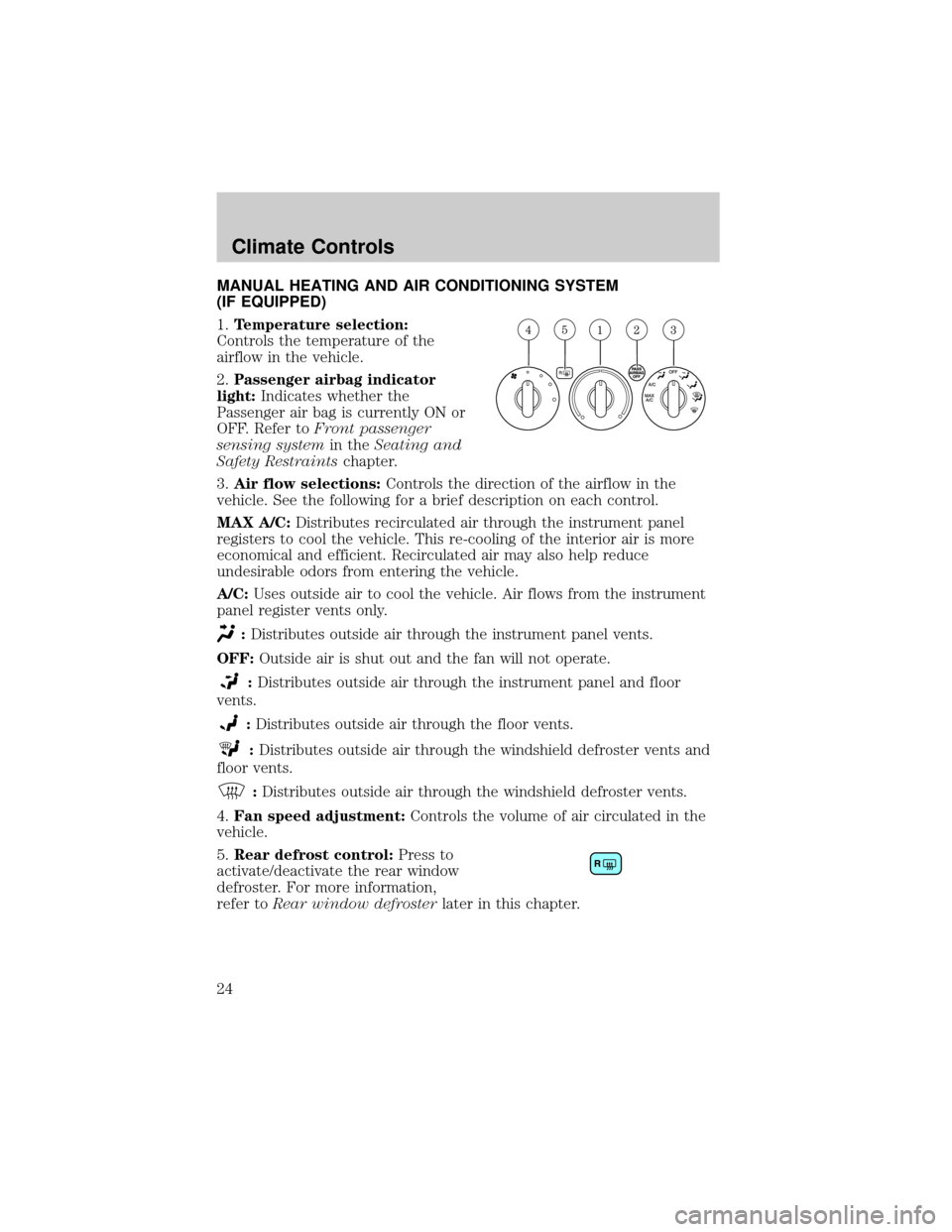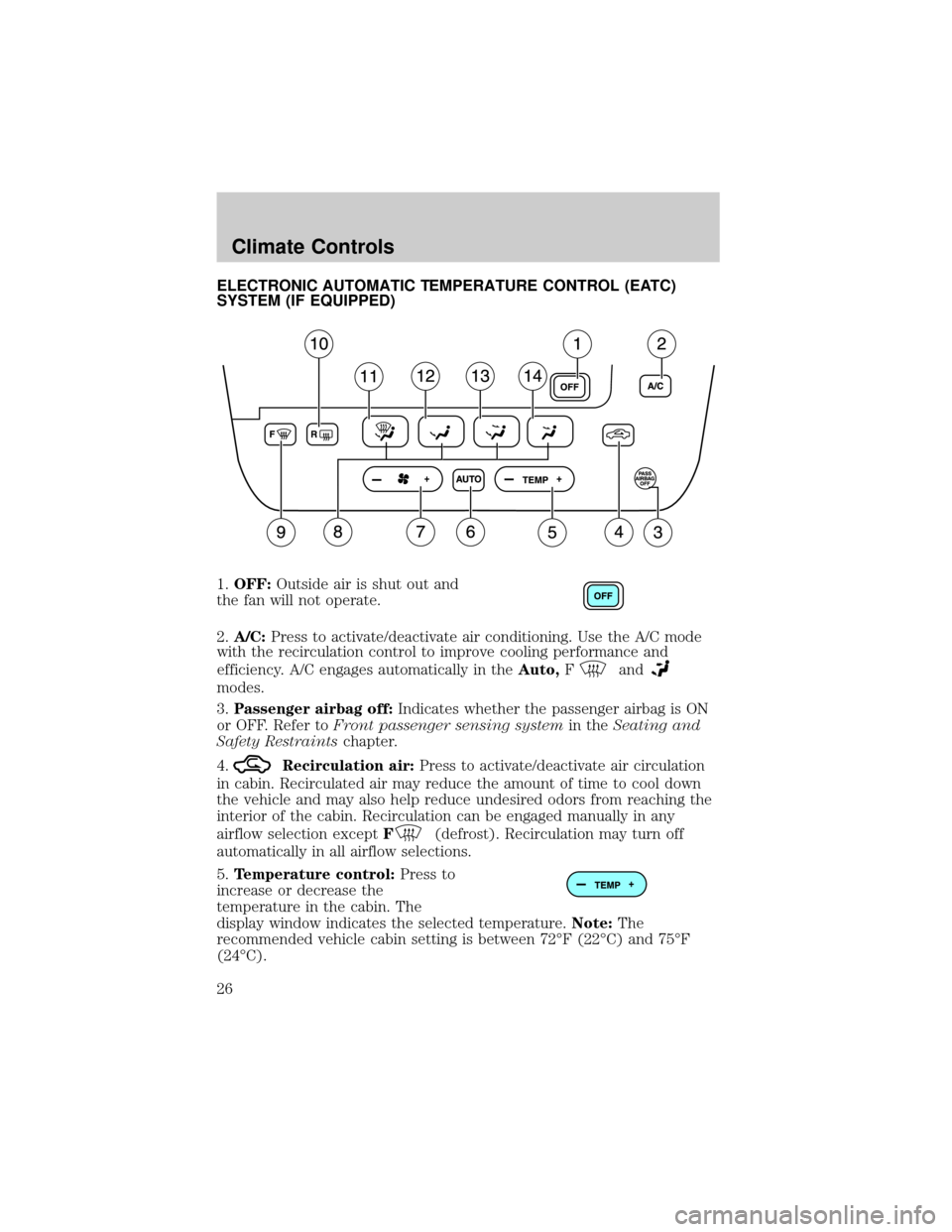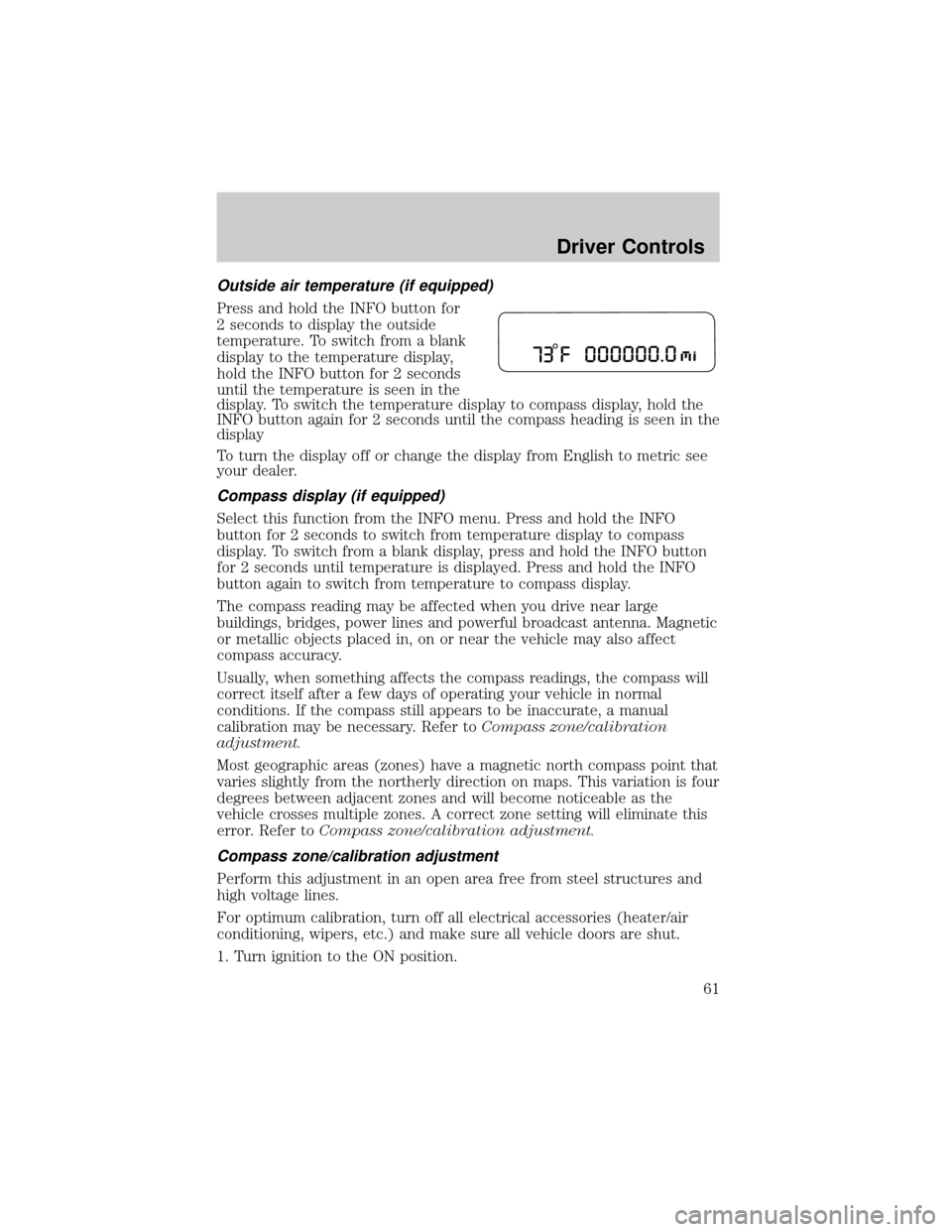2005 FORD TAURUS air conditioning
[x] Cancel search: air conditioningPage 1 of 248

Introduction 4
Instrument Cluster 10
Warning and control lights 10
Gauges 13
Entertainment Systems 15
AM/FM stereo 15
AM/FM stereo cassette 16
AM/FM stereo with CD 19
CD changer 21
Climate Controls 24
Manual heating and air conditioning 24
Electronic automatic temperature control 26
Rear window defroster 28
Lights 30
Headlamps 30
Turn signal control 33
Bulb replacement 35
Driver Controls 46
Windshield wiper/washer control 46
Steering wheel adjustment 47
Power windows 48
Mirrors 50
Speed control 51
Message center 58
Locks and Security 73
Keys 73
Locks 73
Anti-theft system 83
Table of Contents
1
Table of Contents
Page 24 of 248

MANUAL HEATING AND AIR CONDITIONING SYSTEM
(IF EQUIPPED)
1.Temperature selection:
Controls the temperature of the
airflow in the vehicle.
2.Passenger airbag indicator
light:Indicates whether the
Passenger air bag is currently ON or
OFF. Refer toFront passenger
sensing systemin theSeating and
Safety Restraintschapter.
3.Air flow selections:Controls the direction of the airflow in the
vehicle. See the following for a brief description on each control.
MAX A/C:Distributes recirculated air through the instrument panel
registers to cool the vehicle. This re-cooling of the interior air is more
economical and efficient. Recirculated air may also help reduce
undesirable odors from entering the vehicle.
A/C:Uses outside air to cool the vehicle. Air flows from the instrument
panel register vents only.
:Distributes outside air through the instrument panel vents.
OFF:Outside air is shut out and the fan will not operate.
:Distributes outside air through the instrument panel and floor
vents.
:Distributes outside air through the floor vents.
:Distributes outside air through the windshield defroster vents and
floor vents.
:Distributes outside air through the windshield defroster vents.
4.Fan speed adjustment:Controls the volume of air circulated in the
vehicle.
5.Rear defrost control:Press to
activate/deactivate the rear window
defroster. For more information,
refer toRear window defrosterlater in this chapter.
Climate Controls
Climate Controls
24
Page 26 of 248

ELECTRONIC AUTOMATIC TEMPERATURE CONTROL (EATC)
SYSTEM (IF EQUIPPED)
1.OFF:Outside air is shut out and
the fan will not operate.
2.A/C:Press to activate/deactivate air conditioning. Use the A/C mode
with the recirculation control to improve cooling performance and
efficiency. A/C engages automatically in theAuto,F
and
modes.
3.Passenger airbag off:Indicates whether the passenger airbag is ON
or OFF. Refer toFront passenger sensing systemin theSeating and
Safety Restraintschapter.
4.
Recirculation air:Press to activate/deactivate air circulation
in cabin. Recirculated air may reduce the amount of time to cool down
the vehicle and may also help reduce undesired odors from reaching the
interior of the cabin. Recirculation can be engaged manually in any
airflow selection exceptF
(defrost). Recirculation may turn off
automatically in all airflow selections.
5.Temperature control:Press to
increase or decrease the
temperature in the cabin. The
display window indicates the selected temperature.Note:The
recommended vehicle cabin setting is between 72ÉF (22ÉC) and 75ÉF
(24ÉC).
Climate Controls
26
Page 61 of 248

Outside air temperature (if equipped)
Press and hold the INFO button for
2 seconds to display the outside
temperature. To switch from a blank
display to the temperature display,
hold the INFO button for 2 seconds
until the temperature is seen in the
display. To switch the temperature display to compass display, hold the
INFO button again for 2 seconds until the compass heading is seen in the
display
To turn the display off or change the display from English to metric see
your dealer.
Compass display (if equipped)
Select this function from the INFO menu. Press and hold the INFO
button for 2 seconds to switch from temperature display to compass
display. To switch from a blank display, press and hold the INFO button
for 2 seconds until temperature is displayed. Press and hold the INFO
button again to switch from temperature to compass display.
The compass reading may be affected when you drive near large
buildings, bridges, power lines and powerful broadcast antenna. Magnetic
or metallic objects placed in, on or near the vehicle may also affect
compass accuracy.
Usually, when something affects the compass readings, the compass will
correct itself after a few days of operating your vehicle in normal
conditions. If the compass still appears to be inaccurate, a manual
calibration may be necessary. Refer toCompass zone/calibration
adjustment.
Most geographic areas (zones) have a magnetic north compass point that
varies slightly from the northerly direction on maps. This variation is four
degrees between adjacent zones and will become noticeable as the
vehicle crosses multiple zones. A correct zone setting will eliminate this
error. Refer toCompass zone/calibration adjustment.
Compass zone/calibration adjustment
Perform this adjustment in an open area free from steel structures and
high voltage lines.
For optimum calibration, turn off all electrical accessories (heater/air
conditioning, wipers, etc.) and make sure all vehicle doors are shut.
1. Turn ignition to the ON position.
Driver Controls
61
Page 134 of 248

strongly recommended if you live in a region where temperatures reach
-10ÉF (-23ÉC) or below. For best results, plug the heater in at least three
hours before starting the vehicle. The heater can be plugged in the night
before starting the vehicle.
To reduce the risk of electrical shock, do not use your heater
with ungrounded electrical systems or two-pronged (cheater)
adapters.
Guarding against exhaust fumes
Carbon monoxide is present in exhaust fumes. Take precautions to avoid
its dangerous effects.
If you smell exhaust fumes inside your vehicle, have your dealer
inspect your vehicle immediately. Do not drive if you smell
exhaust fumes.
Important ventilating information
If the engine is idling while the vehicle is stopped for a long period of
time, open the windows at least one inch (2.5 cm) or adjust the heating
or air conditioning to bring in fresh air.
BRAKES
Your service brakes are self-adjusting. Refer to the Scheduled
Maintenance Guide for maintenance recommendations.
Occasional brake noise is normal and often does not indicate a
performance concern with the vehicle's brake system. In normal
operation, automotive brake systems may emit occasional or intermittent
squeal or groan noises when the brakes are applied. Such noises are
usually heard during the first few brake applications in the morning;
however, they may be heard at any time while braking and can be
aggravated by environmental conditions such as cold, heat, moisture,
road dust, salt or mud. If a ªmetal-to-metal,º ªcontinuous grindingº or
ªcontinuous squealº sound is present while braking, the brake linings
may be worn-out and should be inspected by a qualified service
technician.
If the vehicle has continuous vibration or shudder in the steering wheel
while braking, the vehicle should be inspected by a qualified service
technician.
Driving
134
Page 243 of 248

A
Accessory delay ..........................49
Air bag supplemental restraint
system ........................108±109, 115
and child safety seats ............111
description ......................109, 115
disposal ....................................117
driver air bag ..........109, 111, 116
indicator light .........................115
operation .................109, 111, 116
passenger air bag ...109, 111, 116
side air bag ..............................115
Air cleaner filter .......................231
Air conditioning ..........................26
Antifreeze
(see Engine coolant) ................198
Anti-lock brake system
(see Brakes) ..............................135
Anti-theft system ........................86
arming the system ....................86
disarming a triggered system ..86
Audio system
(see Radio) ......................15±16, 19
Automatic transaxle
fluid, adding ............................216
fluid, checking ........................216
fluid, refill capacities ..............232
fluid, specification ..................235
Automatic transmission
driving an automatic
overdrive .................................140
Auxiliary power point .................48
Axle
lubricant specifications ..........234
B
Battery .......................................196acid, treating emergencies .....196
jumping a disabled battery ....165
maintenance-free ....................196
replacement, specifications ...231
servicing ..................................196
BeltMinder .................................103
Brakes ........................................134
anti-lock ...................................135
anti-lock brake system
(ABS) warning light ...............135
fluid, checking and adding ....216
fluid, refill capacities ..............232
fluid, specifications .........234±235
lubricant specifications ..234±235
parking ....................................136
shift interlock ..........................138
Bulbs ............................................35
C
Capacities for refilling fluids ....232
Cargo area shade ........................71
Cargo cover .................................70
Cargo net .....................................70
CD changer .................................21
CD-single premium .........15±16, 19
Cell phone use ............................68
Certification Label ....................238
Changing a tire .........................159
Child safety restraints ..............118
child safety belts ....................118
Child safety seats ......................120
attaching with tether straps ..125
in front seat ............................122
in rear seat ......................122, 124
Cleaning your vehicle
engine compartment ..............182
Index
Index
243
Page 244 of 248

instrument panel ....................184
interior .....................................184
interior trim ............................185
plastic parts ............................183
washing ....................................181
waxing .....................................181
wheels ......................................182
wiper blades ............................184
Climate control (see Air
conditioning or Heating) ............26
Clock adjust
AM/FM Stereo ...........................15
AM/FM/CD .................................19
AM/FM/Tape ..............................16
Compass, electronic ....................61
calibration .................................61
set zone adjustment .................61
Console ........................................67
Controls
power seat .................................90
Coolant
checking and adding ..............198
refill capacities ................202, 232
specifications ..................234±235
Cruise control
(see Speed control) ....................51
Customer Assistance ................150
Ford accessories for your
vehicle .....................................186
Ford Extended Service Plan .174
Getting assistance outside
the U.S. and Canada ..............178
Getting roadside assistance ...150
Getting the service
you need .................................172
Ordering additional owner's
literature .................................179
The Dispute Settlement
Board .......................................174Utilizing the Mediation/
Arbitration Program ...............177
D
Daytime running lamps
(see Lamps) ................................30
Defrost
rear window ..............................28
Dipstick
automatic transmission
fluid ..........................................216
engine oil .................................192
Doors
lubricant specifications ..........234
Driving under special
conditions ..................................141
through water .........................142
E
Electronic message center .........58
Emergencies, roadside
jump-starting ..........................165
Emergency Flashers .................151
Emission control system ..........212
Engine ................................235±236
cleaning ...................................182
coolant .....................................198
idle speed control ...................196
lubrication specifications 234±235
refill capacities ........................232
service points ..................189±190
starting after a collision .........151
Engine block heater .................133
Engine oil ..................................192
checking and adding ..............192
dipstick ....................................192
filter, specifications ........195, 231
Index
244
Page 245 of 248

recommendations ...................195
refill capacities ........................232
specifications ..................234±235
Exhaust fumes ..........................134
F
Flexible Fuel Vehicle (FFV) ....203
Floor mats ...................................69
Fluid capacities .........................232
Fuel ............................................203
calculating fuel economy .60, 209
cap ...........................................205
capacity ...................................232
choosing the right fuel ...........206
comparisons with EPA fuel
economy estimates .................211
detergent in fuel .....................208
filling your vehicle
with fuel ..................203, 205, 209
filter, specifications ........208, 231
fuel pump shut-off switch .....151
improving fuel economy ........209
octane rating ...........207, 235±236
quality ......................................207
running out of fuel .................208
safety information relating to
automotive fuels .....................203
Fuel - flex fuel vehicle
(FFV) .........................203, 206±207
Fuses ..........................................153
G
Garage Door Opener
(see Homelink wireless control
system) ........................................54
Gas cap (see Fuel cap) ............205
Gas mileage
(see Fuel economy) .................209Gauges .........................................13
H
Hazard flashers .........................151
Headlamps ...................................30
aiming ........................................32
autolamp system .......................30
bulb specifications ....................35
daytime running lights .............30
flash to pass ..............................31
high beam .................................31
replacing bulbs .........................37
turning on and off ....................30
Heating
heating and air conditioning
system .................................24, 26
Homelink wireless control
system ..........................................54
Hood ..........................................188
I
Ignition .......................130, 235±236
Infant seats
(see Safety seats) .....................120
Inspection/maintenance
(I/M) testing ..............................213
Instrument panel
cleaning ...................................184
cluster ........................................10
lighting up panel
and interior ...............................31
J
Jack ............................................159
positioning ...............................159
storage .....................................159
Jump-starting your vehicle ......165
Index
245